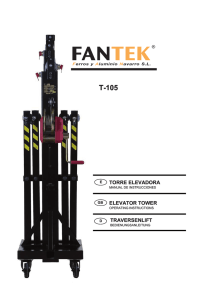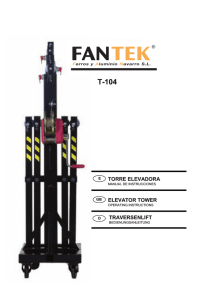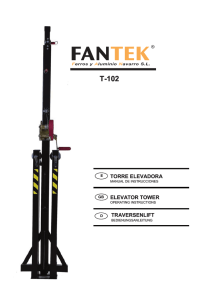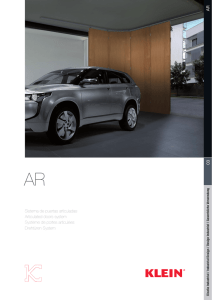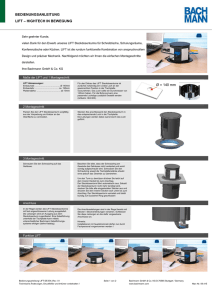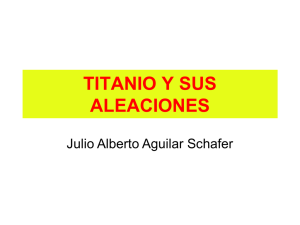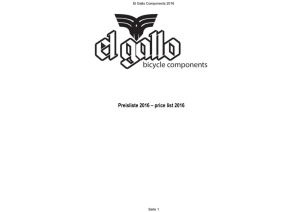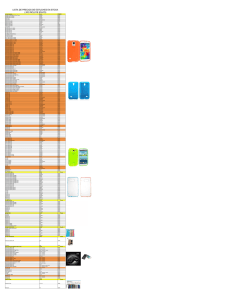B - Fantek
Anuncio
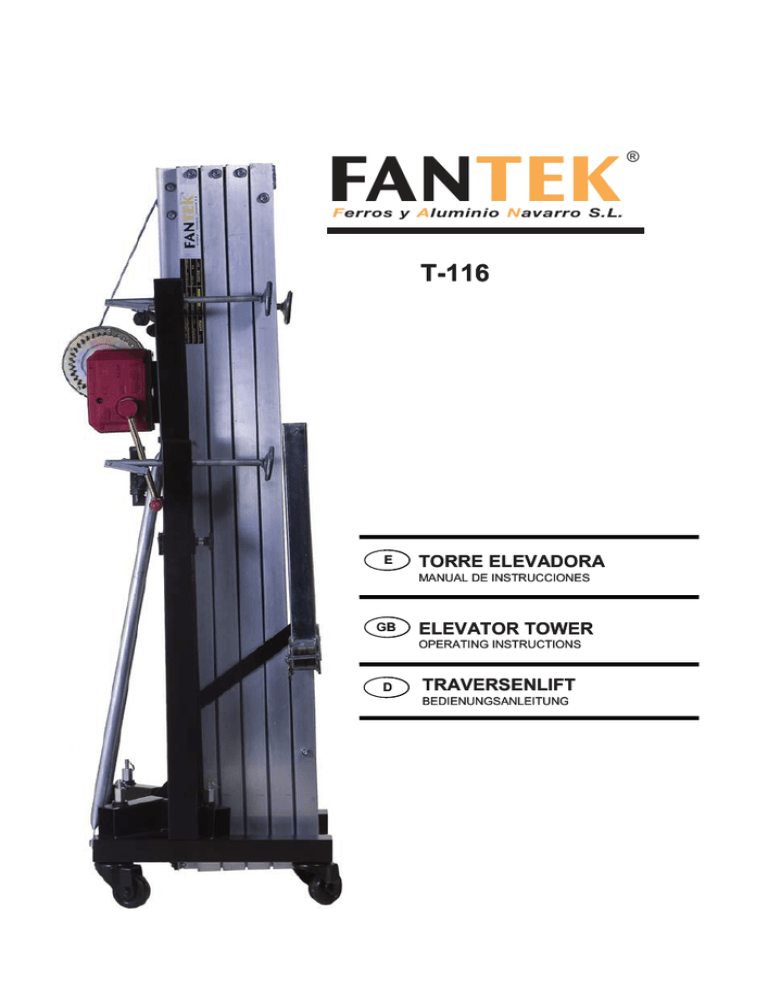
fantek Ferros y Aluminio Navarro S.L. T-116 E TORRE ELEVADORA MANUAL DE INSTRUCCIONES GB ELEVATOR TOWER OPERATING INSTRUCTIONS D TRAVERSENLIFT BEDIENUNGSANLEITUNG ® Ferros y Aluminio Navarro S.L. fantek ® W U S V N1 N2 J L R F H O P Q T Ferros y Aluminio Navarro S.L. fantek ® Ferros y Aluminio Navarro S.L. fantek ® A B T-116/016 A T-116/015 T-116/020 T-116/029 B T-116/020 ACC/26 ACC/26 T-116/002 B1 T-116/026 T-116/026 T-116/003 fantek Ferros y Aluminio Navarro S.L. ® T-116/011 C T-116/005 T-116/006 T-116/012 T-116/013 T-116/010 T-116/014 ACC/28 ACC/19 ACC/29 ACC/21 T-116/007 T-116/009 ACC/13 T-116/001 T-116/016 B1 T-116/021 T-116/025 T-116/004 T-116/026 EN FUNCIONAMIENTO T-116/026 T-116/027 T-116/021 ACC/26 T-116/022 C ACC/14 ACC/14-001 ACC/12-002 ACC/14-002 T-116/024 ACC/14-003 ACC/16-002 ACC/16-004 ACC/16-003 ACC/16 ACC/16-001 ACC/16-004 ACC/16-002 ACC/16-003 ACC/19 ACC/28 T-116/018 T-116/019 T-116/017 ACC/23 T-116/004 T-116/025 BLOQUEADO 1.- Introducción. Estimados señores, con el objetivo de optimizar el uso de nuestra torre elevadora T-116 hemos elaborado este manual. Le rogamos lea atentamente estas instrucciones antes de utilizar la torre. Todos nuestros productos han sido sometidos a las más exigentes pruebas y controles durante el proceso de fabricación. Para que las certificaciones incorporadas al presente manual surtan efecto se deberán emplear repuestos originales en todas las reparaciones. Para cualquier consulta sobre el producto debe indicarse el número de referencia y el año de construcción o número de serie en su defecto. 2.- Datos técnicos. Torre elevadora telescópica modelo T-116. Esta torre está diseñada para levantar cargas en sentido vertical a diferentes alturas seleccionables, como soporte para estructuras y aparatos de iluminación. 2.1.- Carga máxima elevable de 150 Kg. 2.2.- Carga mínima elevable de 25 Kg. 2.3.- Altura máxima: 5,50 m. 2.4.- Altura mínima: 1,70 m. - Altura de carga: 0,20 m. 2.5.- Área de la base: 1,70 x 1,60 m. 2.6.- Área de la base cerrada: 0,42 x 0,42 m. 2.7.- Peso: 85 Kg. 2.8.- Cabestrante de 900 Kg. de carga máxima con freno automático de retención de la carga. Homologado en Dusseldorf según DIN 15020 y VBG 8 con el nº GS03015. 2.9.- Cable: Acero según DIN 3060. Calidad 180 Kg./mm2 resistente a la torsión. Diámetro del cable 5 mm. 2.10.- Material de construcción: Cuerpo principal en perfil de aluminio extrusionado 6082-T6. Base y patas en perfil de acero según EN 10305. 2.11.- Sistema deslizante sobre rodillos de nylatrón de cuatro tramos accionados por cable de acero guiado por poleas acanaladas con cojinetes de rodamiento a bolas. 2.12.- Platillos estabilizadores ajustables en las patas, con apoyos antideslizantes de caucho. 2.13.- Anclaje de las patas por gatillos de seguridad. 2.14.- Sistema de seguridad interno anti-rotura del cable. 2.15.- Nivel de burbuja para ajustar la posición vertical de la torre. 2.16.- Protección antióxido y acabado por anodizado, también en color negro. 2.17.- Dispositivo de conexión de toma a tierra, ACC/29. 2.18.- Ruedas direccionales para el transporte de la torre en posición vertical y plegada hasta su emplazamiento de trabajo. 3.- Medidas de seguridad. 3.1.- Colocar la torre elevadora sólo en superficies duras y planas. 3.2.- Comprobar que las patas están insertadas a fondo y sujetas por los gatillos retenedores de seguridad (R). 3.3.- Comprobar que la torre se encuentra en posición vertical mediante el nivel de burbuja (F) situado en el tramo base. Ajustar, si fuera necesario, con los platillos de apoyo (Q), girando la manivela (H) en el sentido adecuado, siempre manteniendo las ruedas de la base en contacto con el suelo como otro punto de apoyo. 3.4.- Si se utiliza al aire libre, colocar la torre en suelo firme y asegurarla contra la fuerza del viento mediante tirantes de cable de acero. Los tirantes de cable de acero deben tener un diámetro mínimo de 6 mm. 3.5.- En caso de ser necesario se deberá conectar la torre a tierra a través del dispositivo de conexión habilitado para ello, ACC/29. 3.6.- No usar escaleras encima de la torre ni apoyarlas en ella. 3.7.- Cuidado con salientes, cables, etc. Por encima de la torre. 3.8.- No ponerse debajo de la carga. 3.9.- No mover la torre si está cargada o elevada. 3.10.- Antes de utilizar la torre, verificar el estado del cable, éste no debe presentar rotura de hilos o aplastamiento. No usar nunca cables en malas condiciones. 3.11.- No desmontar nunca la manivela del cabestrante (W), ni ningún elemento del mismo en ningún caso. 3.12.- Se recomienda fijar la manivela del cabrestante una vez se disponga la torre en posición de trabajo. 3.13.- La carga mínima para el funcionamiento del freno sin problemas es de 25 Kg. Sin esta carga mínima el freno no actuará. 3.14.- No engrasar ni lubricar el mecanismo de freno del cabestrante. 3.15.- No autorizada para elevador de personas. 3.16.- Para el transporte hay que bajar todos los tramos y asegurar el bloqueo de los tramos, con el freno (O) correspondiente. 4.- Instrucciones de uso. 4.1.- Colocar la torre elevadora sobre una superficie plana y firme en su emplazamiento de trabajo. 4.2.- Sacar las patas (P) de su soporte para transporte (S) e insertarlas a fondo en sus alojamientos de trabajo (V) comprobando que quedan sujetas por los gatillos retenedores de seguridad (R). Las patas largas se deben disponer sobre la parte frontal y las patas cortas sobre la parte trasera. FIGURA 1 Introducir las Patas Comprobar los Gatillos de Seguridad 4.3.- Ajustar la posición vertical de la torre mediante los platillos de apoyo regulables (Q) girando las manivelas (H) en el sentido necesario para lograr que la burbuja del indicador de nivel (F) quede centrada en el círculo. Hay que tener en cuenta que cuando se lleve a cabo la nivelación se deberán mantener las ruedas de transporte en contacto con el suelo como otro punto de apoyo. FIGURA 2 Regulación de los Platillos 4.4.- Sacar los horquillas de carga (U) quitando los pasadores (L), y colocarlos en posición para soportar la carga. Colocar los pasadores de seguridad. FIGURA 3 2 2 1 1 Quitar los pasadores (L) 3 Sacar las horquillas de carga (U) 4 3 Posicionar las horquillas en posición 4 Colocar los pasadores de seguridad La posición de las horquillas de carga (U) en posición de cargar debe ser tal que la indicación quede en la parte superior y se de una inclinación como se muestra en la siguiente imagen. FIGURA 4 Orientación correcta de la horquillas 4.5.- Colocar la carga a elevar sobre las horquillas de la torre mediante un soporte adecuado según el caso, de forma que el peso de la carga solo actúe en sentido vertical. La carga deberá ser como mínimo de 25 Kg. La carga máxima recomendada nunca deberá estar más desplazada de 25 cm, desde la parte trasera de las horquillas de carga. FIGURA 5 25 cm Carga Máxima Posición de la carga 4.6.- En los montajes que se utilicen varias torres de carga frontal, T-107, T-116 y T-117, se recomienda el uso de estas torres de forma que en queden encaradas de dos en dos, compensándose de esta forma las cargas soportadas por ambas torres, e incrementando así considerablemente la estabilidad del conjunto. FIGURA 6 Ejemplo de montaje de 2 torres 4.7.- No se recomienda el uso de la torre como soporte individual para cualquier aplicación. Este tipo de instalaciones puede afectar seriamente a su estabilidad, especialmente con cargas suspendidas que pueden ser movidas por el viento u otra fuerza externa, incrementando la necesaria resistencia debido a la aplicación de fuerzas dinámicas sobre la torre. FIGURA 7 4.8.- Elevación: Quitar el freno (O) y elevar la torre girando la manivela del cabestrante (W) en el sentido de las agujas del reloj (N1), elevando la carga hasta la altura deseada. FIGURA 8 1 2 Quitar el freno (O) de los tramos Giro del cabrestante y elevación del tramo 4.9.- Aguantar: Soltar la manivela del cabestrante (W), esta se mantendrá en esa posición por la actuación del freno automático accionado por la carga. FIGURA 9 Posición de la torre elevada La torre puede dejarse en cualquier posición intermedia que se necesite, soltando simplemente la manivela. Se recomienda trabar la manivela del cabestrante con una cadena para evitar la manipulación por personas ajenas. 4.10.- Descenso: La maniobra de descenso se consigue de la manera contraria. Girar la manivela del cabestrante (W) en sentido contrario a las agujas del reloj (N2) descendiendo la carga hasta que vayan bajando los diferentes tramos hasta que la torre quede completamente plegada a su altura mínima. fantek Ferros y Aluminio Navarro S.L. ® FIGURA 10 fantek Ferros y Aluminio Navarro S.L. ® Giro del cabrestante y descenso del tramo Posición final de la operación de descenso La torre puede dejarse en cualquier posición intermedia que se necesite del mismo modo que al subir la carga. Si durante la operación de ascenso o descenso de la torre ésta queda bloqueada por el freno de seguridad, elevar la torre hasta su máxima altura para desbloquearla y continuar con el descenso de forma lenta y continua. 4.11.- Para transportar la torre es necesario plegarla bajando completamente los tramos. Fijando el carro elevador con el freno (O). Desmontar las patas liberando los gatillos de retención y colocarlas en su posición de transporte (S). Apretar los tornillos de sujeción (J). fantek Ferros y Aluminio Navarro S.L. ® FIGURA 11 Posición de Transporte Es muy importante accionar el freno (O) cuando la torre elevadora vaya a ser transportada para evitar el deslizamiento de los tramos. 5.- Mantenimiento. 5.1.- Comprobar periódicamente el estado del cable. Si un cable presenta rotura de hilos o aplastamiento, debe ser sustituido inmediatamente por otro nuevo. No utilizar la torre elevadora con cables en mal estado. Utilizar solamente cable de acero DIN 3060 resistente a la torsión. 5.2.- La torre elevadora se suministra completamente engrasada de fábrica. No obstante, se recomienda engrasar periódicamente según el uso, la corona dentada del cabestrante, los cojinetes del árbol de accionamiento y el buje, la rosca de la manivela y los tramos. ATENCIÓN: No engrasar ni lubricar el mecanismo del freno. Los discos de freno, han sido engrasados con una grasa especial resistente al calor y la presión. No deben ser utilizados otros productos distintos al original suministrado por la empresa para evitar influir negativamente en el funcionamiento del freno. No es necesario engrasar los discos de freno. 5.3.- La torre elevadora T-116, debe ser comprobada por un experto como mínimo una vez al año de acuerdo con su utilización. 5.4.- Solamente deben utilizarse piezas de repuesto originales para garantizar una continuada seguridad de uso. El usuario pierde todos los derechos de garantía, si incorpora otros repuestos que no sean originales o lleva a cabo cualquier modificación del producto. 5.5.- Para solicitar cualquier pieza de repuesto debe de indicarse el número de referencia que figura en las hojas de despiece de este manual. REF T-116/001 T-116/002 T-116/003 T-116/004 T-116/005 T-116/006 T-116/007 T-116/008 T-116/009 T-116/010 T-116/011 T-116/012 T-116/013 T-116/014 T-116/015 T-116/016 T-116/017 T-116/018 T-116/019 T-116/020 T-116/021 T-116/022 T-116/023 T-116/024 T-116/025 T-116/026 T-116/027 T-116/028 T-116/029 T-116/030 ACC/13 ACC/12 ACC/12-001 ACC/12-002 ACC/12-003 ACC/16 ACC/16-001 ACC/16-002 ACC/16-003 ACC/16-004 ACC/19 ACC/21 ACC/23 ACC/26 ACC/28 ACC/29 DESCRIPCION MATERIAL ACABADO Acero Zincado / Negro Base 116 Acero Zincado / Negro Carro Aluminio Aluminio / Negro Carro Aluminio Aluminio-Latón Aluminio Juego péndulo seguridad Acero-Nylon Galvanizado Cable 5mm Acero Zincado Cabrestante Acero Galvanizado / Negro Tirante Plástico Verde Nivel Base Acero Zincado / Negro Pata corta Acero Zincado / Negro Pata larga Aluminio Aluminio / Negro Tramo base aluminio 1 Aluminio Aluminio / Negro Tramo 2 aluminio Aluminio Aluminio / Negro Tramo 3 aluminio Aluminio Aluminio / Negro Tramo 4 aluminio Acero Zincado Polea 42 Goma Negro Rueda 80 s/plancha c/tornillo Acero Zincado Polea 50 Acero Zincado / Negro Portapolea tramo base Zamak Zamak Portapolea interior Acero Zincado / Negro Pletina sujetacable + Tornillo Nylatron Nylatron Polea nylon Acero Zincado Juego tornillo polea nylon Zamak Zamak Tope interior + Tornillo (Juego) Plástico Negro Tapón plástico pata Plástico Blanco Cuña + Tornillo Acero Zincado Tornillo M10x140 + Tuerca Acero Zincado Pasador 10 + R Acero Zincado Arandelas M12 Acero Zincado Juego tornillo M8x30 + Tuerca Polea Acero Zincado Tornillo base 10x35 + Tuerca Acero Zincado Gatillo seguridad Hexagonal Acero Zincado Estabilizador completo M16 Acero Zincado Maneta estabilizadora Acero Zincado Perno roscado M16 Acero-Caucho Zincado Plato estabilizador Acero Zincado / Negro Freno 116 Acero Zincado / Negro Cuerpo Freno 116 Acero Zincado / Negro Muelle Freno 116 Acero Zincado / Negro Arandela Freno 116 Acero Zincado / Negro Pasador Freno 116 Acero Zincado / Negro Portapatas 116 Acero-Plástico Zincado / Negro Pomo para portapata Acero Zincado / Negro Plancha Cabrestante 116 Acero Zincado Cuernos 116 Acero-Goma Zincado / Negro Asa con Manguito Acero Zincado Dispositivo Toma Tierra 1. Introduction Dear customer. We have written this manual with the objective to optimize the use of our lifting tower T-116. We ask you to read these directions attentively before using the tower. All our products have been submitted to the most exigent tests and controls during the process of fabrication. For the certifications contained in the present manual to take effect, only original spare parts must be used in all repair works. The reference number and the year of construction or the serial number must be indicated for any consultation on the product. 2. Technical specifications Lifting telescopic tower model T-116. This tower is designed to lift loads such as supports for structures and illumination gadgetry in a vertical sense to different heights. 2.1.- Max. load: 150 kg 2.2.- Min. load: 25 kg 2.3.- Max. height: 5,50 m 2.4.- Min. height: 1,70 m Min. height for the load: 0,20 m 2.5.- Base area: 1,70 x 1,60 m 2.6.- Folded base area: 0,42 x 0,42 m 2.7.- Weight: 85 kg 2.8.- Winch: 900 kg. Maximum load with automatic stop load brake. Certified in Düsseldorf according to DIN 15020 and VBG 8 with the number GS03015. 2.9.- Cable: Steel DIN 3060. Tensile strength 180 kg/mm2. Twisting-resistant. 5 mm cable diametre. 2.10.- Construction material: Principal body aluminium profiles 6082-T6. Base and legs steel profiles EN 10305. 2.11.- Four-profile sliding system on nilatron rollers operated by steel cable driven by grooved pulleys with ball-bearing pads. 2.12.- Adjustable stabilizer plates in the legs with nonslip rubber supports. 2.13.- Leg anchorage by safety triggers (R). 2.14.- Internal safety system against cable breakage. 2.15.- Bubble level for vertical alignment of the tower. 2.16.- Antirust protection and electroplated zinc or black finish. 2.17.- Ground connection device, ACC/29. 2.18.- Wheels for transporting the tower in upright or folded position to its working location. 3. Safety precautions 3.1.- Place the tower only on a solid and flat surface. 3.2.- Check that the legs are fully inserted and secured by the retaining safety triggers (R). 3.3.- With the bubble level (F) located at the base profile, check that the tower is in vertical position. If necessary, adjust its alignment with the plates (Q) by turning the handle (H) in the appropriate sense, always keeping the base wheels in touch with the ground as another supporting point. 3.4.- When used out in the open, place the tower on hard ground and secure it against wind force by means of steel cable braces. These steel cable braces must have a minimum diametre of 6 mm. 3.5.- If necessary, the tower must be anchored to the ground with the appropriate connecting device ACC/29. 3.6.- Do not use ladders on the tower nor lean them on it. 3.7.- Be careful with any cables, prominent objects etc. placed above the tower. 3.8.- Do not stand under the load. 3.9.- Do not move the tower when it is elevated with a load. 3.10.- Before using the tower, check the state of the cable. This must be free of cuts and fraying. Never use cables in bad condition. 3.11.- Never dismount the winch handle (W) or any element of the winch under any circumstances. 3.12.- Once the tower is ready in its working position it is recommended to lock the winch handle. 3.13.- The minimum load for a safe operation of the brake is 25 kg. The brake will not function without this minimum load. 3.14.- Do not grease or lubricate the brake mechanism of the winch. 3.15.- Not permitted for use as passenger lift. 3.16.- For transportation it is necessary to retract all profiles and lock them with the brake (O). 4. Operation 4.1.- Place the tower on a flat and solid surface in its site of operation. 4.2.- Pull the legs out of their support for transport (S) and insert them in their working lodges (V). Check that they are fully inserted and fastened by the retaining safety triggers (R). The long legs must be mounted at the front and the short ones at the rear. SEE FIGURE 1. 4.3.- Adjust the vertical alignment of the tower with the support plates (Q) by turning the handle (H) in the required sense until the bubble of the level (F) becomes centered in the circle. When leveling the tower, the transport wheels must have firm contact with the ground as another supporting point. SEE FIGURE 2. 4.4.- Extract the loading forks (U) after removing the safety bolts (L) and bring them into position to support the load. Then put in the safety bolts. SEE FIGURE 3. In their loading position, the loading forks (U) must be aligned so that the indication mark appears on the topside showing a slope as illustrated in the following picture. SEE FIGURE 4. 4.5.- Place the load to lift on the tower forks by means of a suitable support so that the load can only move in a vertical sense. The minimum load must be at least 25 kg. The maximum recommended load must never be placed farther than 25 cm from the first tower section. SEE FIGURE 5. 4.6.- In set-ups with several front towers such as the T-107, T-116 and T-117 models, it is recommended to put up these towers facing back to back, thereby balancing the loads carried by both towers and making the assembly considerably stronger. SEE FIGURE 6. 4.7.- We don’t recommend to use the tower as individual support for any application. Such installations can seriously affect the stability of the tower, especially with hanging loads which can be moved by the wind or any other external force. This requires the load to have a greater resistance to dynamic forces which may act upon the tower. SEE FIGURE 7. 4.8.- Up: Release the brake (O) and lift the tower by turning the winch handle clockwise (N1) to raise the load to the required height. SEE FIGURE 8. 4.9.- Hold: Releasing the winch handle (W) will activate the winch's automatic brake. SEE FIGURE 9. The tower may be stopped in any desired intermediate position just by releasing the handle. It is recommended to secure the winch handle with a chain to avoid manipulations by unauthorized people. 4.10.- Down: Descending the load is done the other way round. Turn the winch handle (W) counterclockwise (N2) to lower the load and retract the individual profiles until the tower is completely folded down to its minimal height. SEE FIGURE 10. Just like when lifting the load, the tower may be stopped in any desired intermediate position. If the tower should become blocked by the emergency brake during the up or down movement, extend the tower to its maximum height to unlock it and continue the operation, moving the winch handle in a slow and steady way. 4.11.- For transport it is necessary to fold down the tower completely. Fix the cart with the brake (O). Dismount the legs by releasing the retention triggers and place them in their transporting position (S). Press the fixing screws (J). SEE FIGURE 11. It is very important to activate the brake (O) when the lifting tower is going to be transported to avoid slipping of the profiles. 5. Maintenance 5.1.- All cables must be checked regularly. Faulty cables need to be replaced immediately. Do not use the lifting tower with faulty cables. It is dangerous. Use only torsion-free steel cables according to DIN 3060 standard. 5.2.- The tower is delivered ex works completely greased. Depending on its mechanical strain, however, it is recommended to grease the crown wheel of the winch, the pads and bushings of the drive shaft, the thread of the handle and the profiles of the tower periodically. ATTENTION: Do not apply oil or grease to the brake mechanism. The brake discs have been pregreased with a special heat and pressure resistant grease. To avoid malfunctions of the winch brake, no other products must be used except the original provided by the company. It is not necessary to grease the brake discs. 5.3.- The lifting tower T-116 must be inspected at least once a year by a specialized technician. 5.4.- Only original spare parts must be used to ensure a consistent operational safety. The user shall lose all warranty claims if he uses any other than original spare parts or modifies the product in any way. 5.5.- In case a spare part is required, it is necessary to indicate its reference number which can be found in the spare parts table in this manual. SEE TABLE 1. 1. Einführung Sehr geehrter Anwender, dieses Manual wurde mit dem Ziel einer optimalen Nutzung unseres Hublifts T-116 verfasst. Wir bitten Sie, vor Benutzung des Lifts diese Anleitung aufmerksam durchzulesen. Alle unsere Produkte durchlaufen während des Herstellungsprozesses strenge Tests und Kontrollen. Damit die im vorliegenden Manual enthaltenen Bescheinigungen ihre Gültigkeit behalten, müssen bei allen Reparaturen stets Original-Ersatzteile verwendet werden. Für jede Produktberatung müssen Referenznummer und Baujahr oder Seriennummer angegeben werden. 2. Technische Daten Teleskop-Turmlift Modell T-116. Dieser Lift ist dafür ausgelegt, Lasten wie beispielsweise Traversen und Beleuchtungselemente in senkrechter Richtung auf unterschiedliche Nutzhöhe anzuheben. 2.1. – Maximallast: 150 kg 2.2. – Mindestlast: 25 kg 2.3. – Max. Höhe: 5,50 m 2.4. – Min. Höhe: 1,70 m. Min. Lasthöhe: 0,20 m 2.5. – Stellfläche: 1,70 x 1,60 m 2.6. – Stellfläche zusammengeklappt: 0,42 x 0,42 m 2.7. – Gewicht: 85 kg 2.8. – Seilwinde: 900 kg Höchstlast mit automatischer Lastbremse. Zertifiziert in Düsseldorf nach DIN 15020 und VBG 8 mit der Prüfnummer GS03015. 2.9. – Kabel: Stahl DIN 3060. Zugfestigkeit: 180 kg/mm2. Verdrillsicher. 5 mm Seildurchmesser. 2.10. – Aufbau: Hauptkörper aus Aluprofilen 6082-T6. Basis und Standbeine aus Stahlprofilen EN 10305. 2.11. – Teleskopsystem mit vier Profilen auf Nilatron-Rollen. Antrieb über Stahlseil in kugelgelagerten Führungsscheiben. 2.12. – Justierbare Stabilisierungsplatten in den Standbeinen mit rutschsicheren Gummifüßen. 2.13. – Verankerung der Beine über Sicherungstrigger (R). 2.14. – Internes Sicherungssystem gegen Seilbruch. 2.15. – Wasserwaage zur vertikalen Ausrichtung. 2.16. – Rostschutzfinish in Zink oder schwarz eloxiert. 2.17. – Bodensicherung ACC/29. 2.18. – Räder zum Transport des Lifts in senkrechter Position sowie in eingefahrenem Zustand zum Einsatzort. 3. Sicherheitshinweise 3.1. – Den Lift nur auf stabilen, ebenen Flächen aufstellen. 3.2. – Vergewissern Sie sich, dass die Beine voll eingeschoben und mit den Sicherungstriggern (R) gesichert sind. 3.3. – Mit Hilfe der im Basisprofil eingelassenen Wasserwaage (F) prüfen, ob der Lift absolut senkrecht steht. Gegebenenfalls mit den Platten (Q) ausgleichen, hierzu die Kurbel (H) in der entsprechenden Richtung drehen; dabei müssen die Räder der Grundplatte als zusätzliche Stützpunkte ständigen Bodenkontakt haben. 3.4. – Bei Benutzung im Freien den Lift auf festen Boden stellen und durch Spannstreben mit Stahlseilen von mindestens 6 mm Durchmesser gegen Scherwinde sichern. 3.5. – Falls notwendig, den Lift mit dem hierfür vorgesehenen Verbindungselement ACC/29 am Boden verankern. 3.6. – Auf dem Lift keine Leitern verwenden und auch nicht daran anlehnen. 3.7. – Auf über dem Lift hängende Kabel, vorstehende Teile usw. achten. 3.8. – Nicht unter der Last stehenbleiben. 3.9. – Den Lift nicht mit angehobener Last bewegen. 3.10. – Vor Benutzung des Lifts den Zustand des Kabels prüfen. Dieses darf keine spröden Adern aufweisen oder ausgefranst sein. Kabel in schlechtem Zustand dürfen keinesfalls verwendet werden! 3.11. – Unter keinen Umständen die Windenkurbel (W) oder irgendein Bauteil der Winde abschrauben. 3.12. – Es wird empfohlen, die Windenkurbel zu arretieren, sobald der Lift in seiner Arbeitsposition steht. 3.13. – Die Mindestlast für einen problemlosen Betrieb der Bremse beträgt 25 kg. Ohne diese Mindestlast funktioniert die Bremse nicht korrekt. 3.14. – Den Bremsmechanismus der Winde weder schmieren noch ölen. 3.15. – Nicht als Personenlift zugelassen. 3.16. – Zum Transport müssen alle Profile heruntergefahren und mit der Bremse (O) blockiert werden. 4. Betrieb 4.1. – Den Lift an seinem Einsatzort auf einer stabilen, ebenen Fläche aufstellen. 4.2. – Die Beine aus ihrer Transporthalterung (S) herausziehen und in ihre Arbeitsposition (V) einführen; darauf achten, dass sie ganz eingeschoben und mit den Sicherungstriggern (R) arretiert sind. Die langen Ausleger müssen nach vorn zeigen, die kurzen nach hinten. SIEHE ABBILDUNG 1 4.3. – Die vertikale Position des Lifts mit Hilfe der Stützplatten (Q) ausrichten. Die Kurbel (H) solange in die erforderliche Richtung drehen, bis sich die Luftblase der Wasserwaage mittig im Kreis befindet. Beim Ausrichten müssen die Transportrollen als zusätzliche Stützpunkte ständigen Bodenkontakt haben. SIEHE ABBILDUNG 2 4.4. – Nach Entfernen der Sicherungsbolzen (L) die Lastträger (U) ausziehen und in Position zur Lastaufnahme bringen. Die Sicherungsbolzen wieder einstecken. SIEHE ABBILDUNG 3 Die Lastträger (U) müssen so zur Last hin ausgerichtet werden, dass die Markierung auf der Oberseite sichtbar ist und eine Schräge aufweist, wie in der folgenden Abbildung gezeigt ist. SIEHE ABBILDUNG 4 4.5. – Die anzuhebende Last mittels einer geeigneten Haltevorrichtung so auf den Lastträgern des Lifts platzieren, dass sie sich nur in vertikaler Richtung bewegen kann. Das Lastgewicht muss mindestens 25 kg betragen und die Last darf sich nie weiter als 25 cm vom hinteren Ende der Lastträger befinden. SIEHE ABBILDUNG 5 4.6.- Bei Einsatz mehrerer Frontlifte wie etwa der Modelle T-107, T-116 und T-117 wird empfohlen, diese Tower mit den Rückseiten zueinander aufzustellen, da hierdurch die von beiden Liften getragenen Lasten besser ausbalanciert sind und der gesamte Aufbau wesentlich stabiler wird. SIEHE ABBILDUNG 6 4.7.- Wir raten davon ab, den Tower als Einzellastträger zu verwenden. Solche Installationen können die Stabilität des Towers erheblich beeinträchtigen, vor allem bei Hängelasten, die vom Wind oder durch irgendwelche anderen Kräfte bewegt werden können. Hierzu müsste die Last unempfindlicher sein gegen die dynamische Kräfte, welche auf den Tower einwirken können. SIEHE ABBILDUNG 7 4.8. – Anheben Die Bremse (O) lösen und den Lift durch Drehen der Windenkurbel (W) im Uhrzeigersinn (N1) hochfahren, bis die Last die benötigte Höhe erreicht hat. SIEHE ABBILDUNG 8 4.9. – Fixieren Nach Loslassen des Kurbelgriffs (W) wird dieser durch die automatische Windenbremse arretiert. SIEHE ABBILDUNG 9 Der Lift kann in jeder beliebigen Zwischenhöhe angehalten werden – einfach die Kurbel loslassen. Es wird empfohlen, die Windenkurbel mit einer Kette gegen Manipulationen durch unbefugte Personen zu sichern. 4.10. – Absenken Das Herablassen der Last erfolgt in der umgekehrten Reihenfolge. Den Kurbelgriff (W) gegen den Uhrzeigersinn (N2) drehen, damit sich die einzelnen Profile ineinander schieben, bis der Lift wieder auf seine minimale Höhe eingefahren ist. SIEHE ABBILDUNG 10 Der Lift kann wie beim Hochfahren in jeder benötigten Zwischenhöhe angehalten werden. Sollte der Lift während des Hebe- oder Absenkvorgangs durch die Notbremse blockieren, den Lift auf maximale Höhe ausfahren, um die Bremse zu lösen. Danach den Vorgang unter langsamem und gleichmäßigem Drehen der Windenkurbel fortsetzen. 4.11. – Zum Transport des Lifts müssen die Profile vollständig zusammengeschoben werden. Den Rollwagen mit der Bremse (O) fixieren. Die Beine nach Abziehen der Sicherungstrigger abnehmen und in ihre Transportposition (S) bringen. Die Fixierschrauben (J) eindrücken. SIEHE ABBILDUNG 11 Vor dem Transport des Lifts unbedingt die Bremse (O) aktivieren, damit die Profile nicht herausgleiten können. 5. Wartung 5.1. – Alle Seile müssen regelmäßig überprüft und defekte Seile sofort ersetzt werden. Achtung: Den Hublift nicht mit defekten Seilen betreiben! Nur verdrillsichere Stahlseile gemäß DIN 3060 verwenden. 5.2. – Der Lift wird ab Werk vollständig geschmiert ausgeliefert. Je nach Beanspruchung ist es allerdings ratsam, das Antriebskegelrad der Winde, Druckflächen und Laufbuchse der Antriebsachse, das Kurbelgriffgewinde sowie die Liftprofile gelegentlich nachzuschmieren. ACHTUNG: Den Bremsmechanismus nicht ölen oder schmieren. Die Bremsscheiben wurden mit wärme- und druckresistentem Spezialfett vorgeschmiert. Um die Funktion der Windenbremse nicht zu beeinträchtigen, dürfen keine anderen als die von der Firma gelieferten Originalteile verwendet werden. Die Bremsscheiben brauchen nicht geschmiert zu werden. 5.3. – Der Hublift T-116 muss mindestens einmal pro Jahr durch einen fachkundigen Techniker überprüft werden. 5.4. – Um eine dauerhafte Betriebssicherheit zu gewährleisten, dürfen nur OriginalErsatzteile verwendet werden. Der Betreiber verliert sämtliche Garantieansprüche, sobald er andere als OriginalErsatzteile einbaut oder irgendwelche Veränderungen an dem Produkt vornimmt. 5.5. – Wird irgendein Ersatzteil benötigt, muss dessen Referenznummer laut den in dieser Anleitung enthaltenen Ersatzteilabbildungen angegeben werden. SIEHE TABELLE 1. fantek Ferros y Aluminio Navarro S.L. DECLARACION CE DE CONFORMIDAD D. JOSE LUIS NAVARRO NAVARRO en calidad de Administrador de la empresa FERROS Y ALUMINIO NAVARRO S.L., fabricante de FABRICANTE DE ESTRUCTURAS Y ELEMENTOS DE ELEVACIÓN PARA EL SECTOR DEL ESPECTÁCULO con domicilio social en Polígono Industrial El Boni, Camí del Port nº 3, Catarroja, Valencia, declara bajo su única responsabilidad que la máquina, MARCA: DESCRIPCIÓN: MODELO: AÑO DE CONSTRUCCIÓN: PESO: CARGA MÁXIMA ADMISIBLE: Torre T-116 Torre telescópica de elevación de carga. T-116 85 Kg 150 kg se halla en conformidad con la Directiva de Máquinas 98/37/CE. que en su diseño y fabricación han sido tenidos en cuenta tanto en su totalidad como parcialmente, los aspectos recogidos en las normas armonizadas siguientes: UNE EN ISO 12100 – 1:2004 “Seguridad de las máquinas. Conceptos básicos, principios generales para el diseño. Parte 1: Terminología básica, metodología” UNE EN ISO 12100 – 2:2004 “Seguridad de las máquinas. Conceptos básicos. Principios generales para el diseño. Parte 2: Principios y especificaciones técnicas” cumpliendo también las normas nacionales alemanas: BGV C1 (GUV/VC1) / BGG 912 (GUV-G912) con certificado de ensayo 084/2005. habiendo constituido el correspondiente expediente técnico de construcción; y para que conste a los efectos oportunos emite la presente declaración de conformidad. En Catarroja a 7 de Julio de 2006 Firmado: José Luis Navarro Navarro Administrador ® fantek Ferros y Aluminio Navarro S.L. EC DECLARATION OF CONFORMITY Mr. JOSE LUIS NAVARRO NAVARRO as the General Manager of the company FERROS Y ALUMINIO NAVARRO S.L., MANUFACTURER OF STRUCTURES AND ELEVATION TOWERS FOR THE SPECTACLES INDUSTRY whose address is Polígono Industrial El Boni, Camí del Port nº 3, Catarroja, Valencia, Spain, declares in his own responsibility that the machine MARK: DESCRIPTION: MODEL: YEAR OF CONSTRUCTION: WEIGHT: ADMISSIBLE PEAK LOAD: Tower T-116 Telescopic tower for elevating loads T-116 85 kg 150 kg complies with the following requirements in their standard design: Machinery Directive 98/37/EEC and that in its design and fabrication, the following harmonized norms were taken into account: EN ISO 12100 – 1:2004 “Safety of machinery. Basic concepts, general principles for design. Part 1: Basic terminology, methodology” EN ISO 12100 – 2:2004 “Safety of machinery. Basic concepts, general principles for design. Part 2: Technical principles” The above-mentioned machine has been tested in accordance with the following German standards: BGV C1 (GUV/VC1) / BGG 912 (GUV-G912) with test certificate 084/2005 by: IBB Ingenieure Nollendorfstrasse 18 45472 Mülheim an der Ruhr GS test certificate No. 084/2005. Catarroja, July 07, 2006 Signed: José Luis Navarro Navarro General Manager ® fantek Ferros y Aluminio Navarro S.L. EU-KONFORMITÄTSERKLÄRUNG Als Generaldirektor der Firma FERROS Y ALUMINIO NAVARRO S.L., HERSTELLER VON APPARATUREN UND HUBLIFTEN FÜR DIE VERANSTALTUNGSINDUSTRIE mit Firmensitz Polígono Industrial El Boni, Camí del Port No. 3, Catarroja, Valencia, Spanien, erklärt Herr JOSE LUIS NAVARRO in eigener Verantwortung, dass das nachfolgende Gerät TYP: BESCHREIBUNG: MODElL: BAUJAHR: GEWICHT: ZULÄSSIGE HÖCHSTLAST: Tower T-116 Teleskop-Hublift für Lasthebungen T-116 85 kg 150 kg in seiner serienmäßigen Ausführung den folgenden Anforderungen entspricht: Maschinenrichtlinie 98/37/EEC und dass bei seiner Konzeption und Herstellung die folgenden harmonisierten Normen berücksichtigt wurden: EN ISO 12100 – 1:2004 ’Sicherheit von Maschinen - Grundbegriffe, allgemeine Gestaltungsleitsätze - Teil 1 : Grundsätzliche Terminologie, Methodologie.’ EN ISO 12100 – 2:2004 ’Sicherheit von Maschinen - Grundbegriffe, allgemeine Gestaltungsleitsätze - Teil 2 : Technische Leitsätze.’ Das oben genannte Gerät wurde in Übereinstimmung mit deutschen Normen geprüft. BGV C1 (GUV/VC1) / BGG 912 (GUV-G912) mit Prüfzertifikat 084/2005 durch: IBB Ingenieure Nollendorfstraße 18 45472 Mülheim a. d. Ruhr GS-Prüfzertifikat Nr. 084/2005. Catarroja, 07. Juli 2006 Unterzeichnet: José Luis Navarro Navarro Generaldirektor ® Número de serie: Primer test en fábrica. Fecha/Date/Datum Examen a los cuatro años. Serial number : First test in factory. Laufende Nummer: Erstprüfung im Werk. Testado por/Tested by/Prüfer Four years test. UVV Prüfung (alle 4 Jahre) Fecha/Date/Datum Testado por/Tested by/Prüfer Notas/Notes/ Anmerkung Firma/Signature/ Unterschrift Examen anual a partir del cuarto año. Annual test after the fourth year. UVV Jährlicher Test nach dem vierten Jahr. Fecha/Date/Datum: Testado por/Tested by/Prüfer: Notas/Notes/ Anmerkung: Firma/Signature/ Unterschrift: Fecha/Date/Datum: Testado por/Tested by/Prüfer: Notas/Notes/ Anmerkung: Firma/Signature/ Unterschrift: Fecha/Date/Datum: Testado por/Tested by/Prüfer: Notas/Notes/ Anmerkung: Firma/Signature/ Unterschrift: Fecha/Date/Datum: Testado por/Tested by/Prüfer: Notas/Notes/ Anmerkung: Firma/Signature/ Unterschrift: Fecha/Date/Datum: Testado por/Tested by/Prüfer: Notas/Notes/ Anmerkung: Firma/Signature/ Unterschrift: Todos los tests mencionados solo son obligatorios en aquellos países con regulación específica en la materia, aplicada mediante regulaciones o leyes. Como fabricantes, sumamente recomendamos pasar todos los tests con el objetivo de prevenir cualquier daño y mantener perfectamente nuestras torres elevadoras. All the tests mentioned are only mandatory in those countries with specific regulations in this respect, applicable by domestic rules or laws. As a manufacturer, we highly recommend to pass all the tests to prevent any damage and to ensure a perfect operation of our lifting towers. Alle genannten Tests sind nur in den Ländern vorgeschrieben, wo diesbezüglich spezielle Regelungen gelten, die durch inländische Vorschriften oder Gesetze Anwendung finden. Als Hersteller raten wir dringend zur Durchführung aller Tests, um jeglichen Schaden zu verhindern und einen einwandfreien Betrieb unserer Hublifte zu gewährleisten. Camí del Port, 3 • Pol. Ind. El Boni 46470 • Catarroja (Valencia), Spain Tel.: +34 96 126 01 68 • Fax: +34 96 126 64 56 www.fantek.net • e-mail: [email protected]
